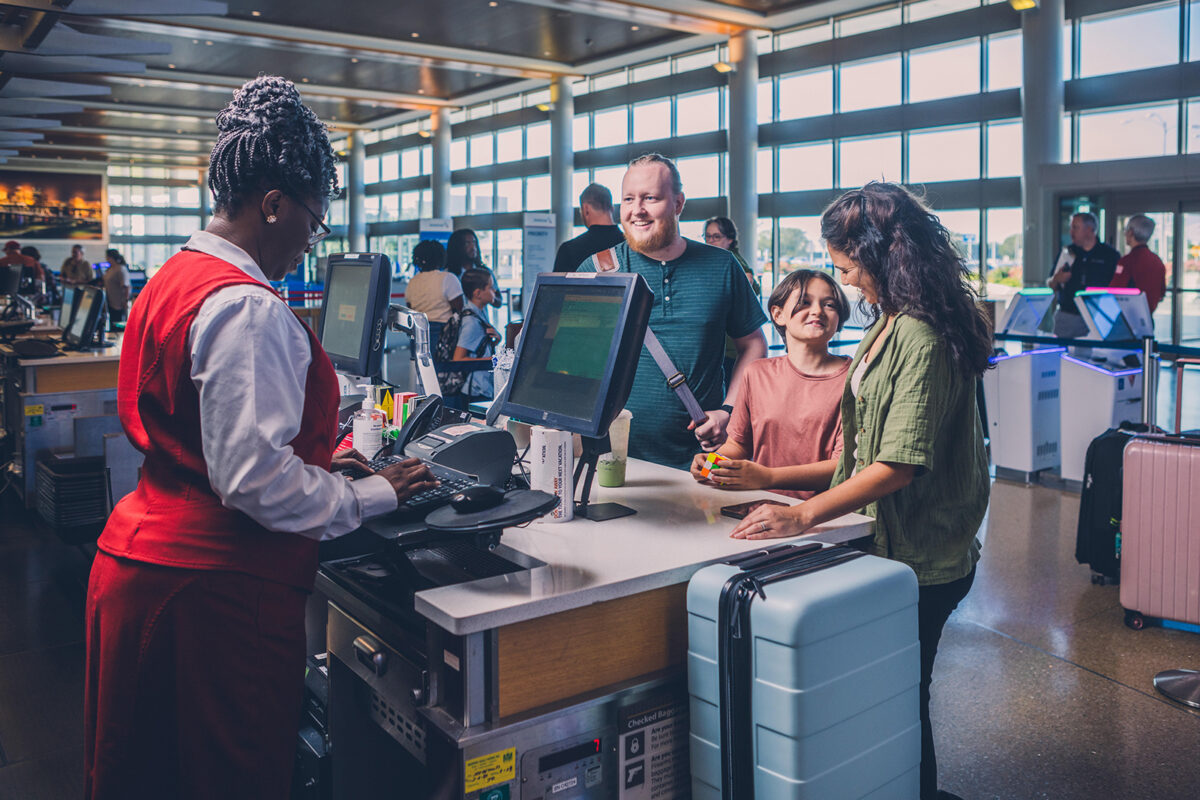Traveling With Children
Whether you’re taking a family trip to Chicago, Florida, or New York for the holidays there are a few steps you can take to ensure your trip is a success.

Traveling With Children Checklist
- First, make sure no children are left home alone before you head to Clinton National Airport. Once the entire family is at the airport, it is essential to know that children 12 years and younger will undergo a modified screening procedure at the TSA checkpoint. Children will NOT be separated from a parent/guardian while going through security.
- Infants/toddlers will need to be removed from their strollers and car seats and can be carried through metal detectors.
- Children under 12 can leave on their shoes, light jackets and headwear during screening.
- Don’t forget snacks, toys and activities to keep children entertained in the terminal and once in the air.

Children with Medical Conditions, Disabilities or Mobility Aids
Let your TSA officer know upfront if your child has a disability, medical condition or medical device. Also, inform TSA of the best way to relieve any concerns during the screening process.
Some children might need to be carried through the metal detector by a parent/guardian. You may carry your child to make the screening process more manageable, and a TSA officer will not remove your child from their mobility aid, wheelchair or scooter.
TSA Cares is a helpline that provides travelers with “disabilities, medical conditions and other special circumstances additional assistance during the security screening process.” Call (855) 787-2227 up to 72 hours before traveling with questions about screening policies, procedures and what to expect at the security checkpoint. You can also call to request assistance at the security checkpoint. Hearing-impaired customers can use the Federal Relay number 711 for assistance with their phone calls.
Clinton National Airport staff are also available to provide additional help as needed. Call (501) 213-6243 in advance of your flight to alert us to any questions, concerns or requests to make sure your children are adequately accommodated.

Liquid Formula, Breast Milk, Toddler Drinks, and Baby/Toddler food
While most liquids and spreadables must be limited to 3.4 ounces or 100 milliliters, there are exceptions when it comes to traveling with infants and toddlers.
Since they are considered medically necessary liquids, breast milk, formula, baby/toddler food (including puree pouches) and toddler drinks can be carried on in larger quantities. Additionally, those items do not have to fit in a single, quart-sized bag. The category also includes cooling accessories, such as ice packs, freezer packs sand gel packs. You can travel with these items and related food/supplies even if your infant is not present.
Before your TSA screening, inform the officer that you are carrying liquid items for an infant/toddler that are more than 3.4 ounces. Those items must be removed from your carry-on bag to be screened separately from your other belongings.
TSA officers can elect to test liquids and accessories for explosives or concealed prohibited items. TSA recommends transporting these items in clear, translucent bottles and not plastic bags or pouches so they can be screened by Bottle Liquid Scanners. Otherwise, you might be asked to open them for alternate screenings.
Screenings will never include placing anything into the medically necessary liquid. TSA screening machines, including X-rays, do not adversely affect food or medicines, but you can inform the TSA officer if you prefer alternate screening methods.

Screening of Children’s Items
All carry-on luggage, including children’s toys, bags and blankets, should be placed on the X-ray belt for screening, along with strollers, baby carriers, car and booster seats and diaper bags/backpacks.
Any equipment too large or bulky to fit through the X-ray machine is subject to visual/physical inspection by TSA officers. Children should always be removed from carriers during the X-ray screening.

Entertainment
You’ll want to pack items to keep your children entertained while on the trip, but it’s essential to be mindful of the types of toys and entertainment items you include in their bags and how you pack them.
Water guns, Nerf guns and similar items are prohibited from being carried onto the plane. Those items must be in your checked luggage and will likely trigger additional screening from TSA officers.
Bubbles and slime are considered liquids and must comply with TSA’s 3-1-1 rule. Passengers are allowed single items of no more than 3.4 ounces. Those bottles must fit into a one-quart bag that is limited to one piece of carry-on luggage.

TSA PreCheck
Did you know 99 percent of travelers with TSA PreCheck need 10 minutes or less to get through security? Enrolling can be completed in three easy steps, and once you’re registered, your shoes can stay on, and the laptop stays in your bag!
Children 12 and under can accompany a parent or guardian with TSA PreCheck on their boarding pass. Passengers 13 and up will need their own TSA PreCheck enrollment.
Here’s how to enroll:
1) Apply online and pay just $78 for a 5-year enrollment.
2) Visit an enrollment location for a 10-minute appointment.
3) Receive your Known Traveler Number (KTN), add it to your reservations and get through screening quicker. You don’t even have to take off your belt and jewelry in line.